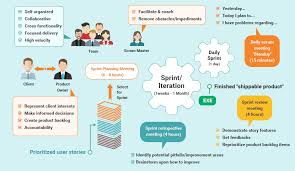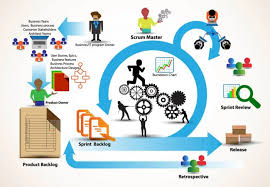Scrum Software Development: A Guide to Agile Project Management
Scrum software development is a popular approach to agile project management that has gained widespread adoption in recent years. It is a flexible, iterative process that allows teams to work together efficiently and effectively to deliver high-quality software products.
The Scrum framework consists of three roles: the Scrum Master, the Product Owner, and the Development Team. The Scrum Master is responsible for facilitating the process and ensuring that everyone adheres to the framework. The Product Owner is responsible for defining the product backlog and prioritizing tasks. The Development Team is responsible for delivering completed product increments at the end of each sprint.
The Scrum process is divided into sprints, which are usually two-week periods during which the team works on specific tasks. At the beginning of each sprint, the team holds a Sprint Planning meeting where they discuss what they will work on during that sprint. They then work on those tasks throughout the sprint and hold daily stand-up meetings to discuss progress and any impediments.
At the end of each sprint, the team holds a Sprint Review meeting where they demonstrate completed work to stakeholders and receive feedback. They also hold a Sprint Retrospective meeting where they reflect on what went well during the sprint and what could be improved in future sprints.
One of the key benefits of Scrum software development is its flexibility. It allows teams to adapt quickly to changing requirements or priorities without disrupting their workflow. It also promotes collaboration among team members, which leads to better communication and more efficient problem-solving.
Another benefit of Scrum is its emphasis on transparency. The framework provides visibility into what each team member is working on, which helps identify potential issues early on in the development process.
Scrum software development has become increasingly popular because it offers a number of benefits over traditional project management approaches. By breaking down complex projects into smaller, manageable tasks and focusing on collaboration and transparency, teams can deliver high-quality software products more efficiently and effectively.
Answers to Frequently Asked Questions about Scrum Software Development
- What is scrum in software?
- How to use scrum in software development?
- What are the 5 elements of Scrum?
- What is scrum in software development life cycle?
What is scrum in software?
Scrum is a framework for agile project management, particularly in software development. It is designed to help teams work together more efficiently and effectively to deliver high-quality software products. The Scrum framework consists of three roles: the Scrum Master, the Product Owner, and the Development Team.
The Scrum Master is responsible for facilitating the process and ensuring that everyone adheres to the framework. The Product Owner is responsible for defining the product backlog and prioritizing tasks. The Development Team is responsible for delivering completed product increments at the end of each sprint.
The Scrum process is divided into sprints, which are usually two-week periods during which the team works on specific tasks. At the beginning of each sprint, the team holds a Sprint Planning meeting where they discuss what they will work on during that sprint. They then work on those tasks throughout the sprint and hold daily stand-up meetings to discuss progress and any impediments.
At the end of each sprint, the team holds a Sprint Review meeting where they demonstrate completed work to stakeholders and receive feedback. They also hold a Sprint Retrospective meeting where they reflect on what went well during the sprint and what could be improved in future sprints.
Scrum allows teams to adapt quickly to changing requirements or priorities without disrupting their workflow. It also promotes collaboration among team members, which leads to better communication and more efficient problem-solving.
Overall, Scrum has become a popular approach in software development because it offers a number of benefits over traditional project management approaches. By breaking down complex projects into smaller, manageable tasks and focusing on collaboration and transparency, teams can deliver high-quality software products more efficiently and effectively.
How to use scrum in software development?
Scrum is an agile project management methodology that can be used in software development to improve team collaboration, increase productivity, and deliver high-quality software products. Here are the steps to use Scrum in software development:
- Define the Product Backlog: The Product Owner should define a prioritized list of features, enhancements, and bug fixes that need to be completed. This list is known as the product backlog.
- Plan the Sprint: The team should plan the sprint by selecting items from the product backlog that they can complete within a fixed time frame (usually 2-4 weeks). They should also identify tasks required to complete each item.
- Hold Daily Stand-Up Meetings: The team should hold daily stand-up meetings where they discuss progress, identify impediments, and plan for the day ahead.
- Work on Tasks: The team members work on individual tasks assigned to them during the sprint.
- Hold Sprint Reviews: At the end of each sprint, the team should hold a sprint review meeting where they demonstrate completed work to stakeholders and receive feedback.
- Hold Sprint Retrospectives: After the sprint review meeting, the team should hold a sprint retrospective meeting where they reflect on what went well during the sprint and what could be improved in future sprints.
- Repeat Steps 2-6: After completing a sprint, repeat steps 2-6 until all items in the product backlog have been completed.
Using Scrum in software development requires commitment from all team members and adherence to its principles and practices. It promotes transparency, collaboration, and continuous improvement which leads to better communication among team members and ultimately results in high-quality software products being delivered on time and within budget constraints.
What are the 5 elements of Scrum?
The Scrum framework consists of five key elements:
Product Backlog: The product backlog is a prioritized list of features, enhancements, and bug fixes that need to be addressed in the software development project.
Sprint Planning: At the beginning of each sprint, the team holds a Sprint Planning meeting where they discuss what work will be completed during the sprint and how it will be accomplished.
Sprint Review: At the end of each sprint, the team holds a Sprint Review meeting where they demonstrate completed work to stakeholders and receive feedback.
Daily Stand-up: The Daily Stand-up is a short meeting held every day where team members discuss progress, identify any roadblocks or impediments, and plan for the day ahead.
5. Sprint Retrospective: The Sprint Retrospective is held at the end of each sprint and is an opportunity for the team to reflect on what went well during the sprint and what could be improved in future sprints.
What is scrum in software development life cycle?
Scrum is an agile framework for software development that emphasizes collaboration, flexibility, and iterative progress. It is a popular methodology used by software development teams to manage complex projects and deliver high-quality software products.
In the Scrum framework, a project is divided into sprints, which are typically two-week periods during which the team works on specific tasks. At the beginning of each sprint, the team holds a Sprint Planning meeting where they discuss what they will work on during that sprint. They then work on those tasks throughout the sprint and hold daily stand-up meetings to discuss progress and any impediments.
The Scrum process consists of three roles: the Scrum Master, the Product Owner, and the Development Team. The Scrum Master is responsible for facilitating the process and ensuring that everyone adheres to the framework. The Product Owner is responsible for defining the product backlog and prioritizing tasks. The Development Team is responsible for delivering completed product increments at the end of each sprint.
At the end of each sprint, the team holds a Sprint Review meeting where they demonstrate completed work to stakeholders and receive feedback. They also hold a Sprint Retrospective meeting where they reflect on what went well during the sprint and what could be improved in future sprints.
One of the key benefits of Scrum in software development life cycle is its flexibility. It allows teams to adapt quickly to changing requirements or priorities without disrupting their workflow. It also promotes collaboration among team members, which leads to better communication and more efficient problem-solving.
Another benefit of Scrum in software development life cycle is its emphasis on transparency. The framework provides visibility into what each team member is working on, which helps identify potential issues early on in the development process.
Scrum in software development life cycle has become increasingly popular because it offers a number of benefits over traditional project management approaches. By breaking down complex projects into smaller, manageable tasks and focusing on collaboration and transparency, teams can deliver high-quality software products more efficiently and effectively.




